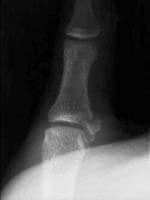Background
Injuries to the ulnar collateral ligament (UCL) of the thumb were first recognized as an occupational condition in European gamekeepers. By repetitively wringing the necks of game (eg, chickens) between their thumb and index finger, these workers produced a chronic stretching of the UCL that resulted in instability at the first metacarpophalangeal (MCP) joint. The condition became known as gamekeeper's thumb. Today, the injury is primarily caused by acute (rather than chronic and repetitive) damage to the UCL, most often due to a skiing accident; hence, the condition is now commonly referred to as skier's thumb.
For patient education resources, see the Hand, Wrist, Elbow, and Shoulder Center and Sports Injury Center, as well as Skier's Thumb and Repetitive Motion Injuries.
NextEpidemiologyFrequencyUnited StatesSkier's thumb represents 5-10% of all skiing injuries; this condition is the most frequent injury of the upper extremity that skiers experience.[1, 2, 3, 4]
PreviousNextFunctional AnatomyThe MCP joint of the thumb is primarily stabilized by the UCL. The origin of this ligament is found on the ulnar aspect of the metacarpal head, whereas the insertion of the UCL is located distally on the proximal phalanx.
PreviousNextSport-Specific BiomechanicsThe most common cause of UCL injury is an acute abducting (radially directed) force upon the thumb.[5] Damage may also result from a combination of torsion, abduction, and hyperextension at the first MCP joint. Depending on the degree of impact of these forces at the MCP joint, the UCL may either tear partially or completely (see the images below).[1, 2, 3, 4]
 Anteroposterior radiograph displaying a gamekeeper's fracture.
Anteroposterior radiograph displaying a gamekeeper's fracture.  Lateral radiograph displaying a gamekeeper's fracture.
Lateral radiograph displaying a gamekeeper's fracture. A large number of skiing injuries are attributed to ski poles, in which the strap or sword grip lies across the palm and transmits the damaging force to the thumb during a fall. Football players may develop UCL damage either traumatically (eg, while making a tackle, falling on an outstretched hand [FOOSH injury]), or chronically (eg, linemen, who repetitively stress the thumb radially while blocking). The injury is also common among athletes who handle balls (eg, basketball, football) and among those who use sticks (eg, hockey, lacrosse), in which the sporting equipment can forcefully abduct the thumb during sport activity.
PreviousProceed to Clinical Presentation , Skier's Thumb






0 comments:
Post a Comment
Note: Only a member of this blog may post a comment.